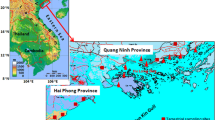Abstract
This study determined the concentrations of 234U, 235U, 238U, 228Th, 230Th, 232Th, 226Ra, 228Ra, and 210Pb in 82 types of food, grouped into 19 groups according to the Brazilian Total Diet, which reflects the dietary habits of the São Paulo State population. Radionuclides were quantified using Ultra low level alpha and beta total counting, and alpha spectrometry, after radiochemical separations. The results of this preliminary work showed that the food groups analyzed gave a consumption of effective dose lower than the dose limit for the public, of 1 mSv year−1.
Similar content being viewed by others
References
WHO—World Health Organization (2007) Regional Office for South-East Asia. Regional Workshop on Total Diet Studies, Jakarta-Indonesia
WHO—World Health Organization (1999) International Workshop in Cooperation with the Pan American Health Organization: GEMS/FOOD TOTAL DIET STUDIES—JOINT USFDA/WHO, Kansas City. Report Geneve. http//www.who.int/foodsafety/publications/chem./tds_aug1999/en. Accessed 08 Jan 2014
WHO—World Health Organization (2002) LATIN. American Total Diet Studies Workshop, Buenos Aires. Report Geneva. http://www.who.int/foodsafety/publications/chem/tds_july2002. Accessed 08 Jan 2014
Avegliano RP, Maihara VA, da Silva FF (2008) Metodologia de Estudo de Dieta Total no Estado de São Paulo para estimativa de ingestão dietética de elementos tóxicos e essenciais: a elaboração da Cesta de Mercado (Market Basket). Ciênc Tecnol Aliment 28(1):90–97
Avegliano RP, Maihara VA, da Silva FF (2011) A Brazilian Total Diet study: evaluation of essential elements. J Food Compos Anal 24(7):1009–1016
Avegliano RP (2009) Estudo de Dieta Total no Estado de São Paulo: Estimativa de Ingestão Dietética de Elementos Tóxicos (arsênio, cádmio e mercúrio) e Essenciais (cálcio, ferro, sódio, selênio e zinco). Doutorado (Tese). Universidade de São Paulo, Brasil
Maihara VA, Fávaro DT, Silva VN, Gonzaga IB, Silva VL, Cunha IL, Vasconcellos MBA, Cozzollino SMF (2001) Analysis of mineral constituents in duplicate portion diets of two university student groups by instrumental neutron activation analysis. J Radioanal Nucl Chem 249(1):21–24
Maihara VA, Gonzaga IB, Silva VL, Fávaro DIT, Vasconcellos MBA, Cozzolino SMF (2004) Daily dietary selenium intake of selected Brazilian population groups. J Radioanal Nucl Chem 59(3):465–468
Garcia F, Barioni A, Arruda-Neto JDT, Deppman A, Milian F, Mesa J, Rodriguez O (2006) Uranium levels in the diet of São Paulo City residents. J Environ Int 32:697–703
Durante M, Manti L (2008) Human response to high-background radiation environments on Earth and in space. Adv Space Res 42:999–1007
WHO—World Health Organization (2011) Information on nuclear accidents and radioactive contamination of foods. International. International Food Safety Authorities Network (INFOSAN). http://www.fao.org/crisis/26810-0e345236a149154263c548a99d710f338.pdf. Accessed 04 Sept 2014
UNSCEAR—United Nations Scientific Committee on the Effects of Atomic Radiation (2000) Sources and effects of ionizing radiation. United Nations, New York, p 652
Taddei MHT, Silva NC, Fernandes EAN, Cipriani M (2001) Determination of alpha-emitting isotopes of uranium and thorium in vegetables and excreta. J Radioanal Nucl Chem 248(2):483–486
Szanto Z, Hult M, Watjen M, Altzitzoglou T (2007) Current radioactivity content of wild edible mushrooms: a candidate for an environmental reference material. J Radioanal Nucl Chem 273(1):167–170
Guillén J, Baeza A, Ontalba MA, Miguez MP (2009) 210Pb and stable lead content in fungi: its transfer from soil. Sci Total Environ 407:4320–4326
Gaburo JC, Todo AS, Taddei MHT, Silva NC (2006) Implementation of alpha-spectrometry for uranium isotopes is excreta samples. J Radioanal Nucl Chem 269(2):499–503
IBGE—Instituto Brasileiro de Geografia e Estatística (2011) Pesquisa de Orçamentos Familiares 2008–2009: Análise de consumo alimentar no Brasil. Rio de Janeiro. http://www.ibge.gov.br/home/estatistica/populacao/condicaodevida/pof/2008_2009_analise_consumo/pofanalise_2008_2009.pdf. Accessed 04 Sept 2014
IAEA—International Atomic Energy Agency (2001) Reference sheet: Reference Material IAEA-327 radionuclides in soil. Viena. http://www.iaea.org/inis/collection/NCLCollectionStore/_Public/32/042/32042411.pdf. Accessed 15 June 2015
IRCP—International Commission on Radiological Protection (2012) Compendium of dose coefficients based on ICRP Publication 60. 41(1): 119. http://www.icrp.org/docs/P%20119%20JAICRP%2041(s)%20Compendium%20of%20Dose%20Coefficients%20based%20on%20ICRP%20Publication%2060.pdf. Accessed 10 Sept 2014
Santos EE, Lauria DC, Amaral ECS, Rochedo ERR (2002) Daily ingestion of 232Th, 238U, 226Ra, 228Ra and 210Pb in vegetables by inhabitants of Rio de Janeiro City. J Environ Radioact 62:75–86
Linsalata P, Eisenbud M, Franca EP (1986) Ingestion estimates of Th and the light rare earth elements based on measurements of human feces. Health Phys 50(1):163–167
Awudu AR, Faanu A, Darko EO, Emi-reynolds G, Adulkpo OK, Kpeglo DO, Otoo F, Lawluvi H, Kpodzro R, Li ID, Obeng MK, Agyeman B (2012) Preliminary studies on 226Ra, 228Ra, 228Th and 40K concentrations in foodstuffs consumed by inhabitants of Accra metropolitan area, Ghana. J Radioanal Nucl Chem 291:635–641
Acknowledgments
The authors would like to thank the Poços de Caldas Laboratory of the Brazilian Nuclear Energy Commission and the Institute of Nuclear Energy Research, the Brazilian National Scientific and Technological Development Council (CNPq), and The Foundation for Research Support of the São Paulo State (FAPESP).
Author information
Authors and Affiliations
Corresponding author
Rights and permissions
About this article
Cite this article
Rosa, M.M.L., Taddei, M.H.T., Cheberle, L.T.V. et al. Determination of 234U, 235U, 238U, 228Th, 230Th, 232Th, 226Ra, 228Ra, and 210Pb in foods from Brazilian Total Diet. J Radioanal Nucl Chem 306, 695–700 (2015). https://doi.org/10.1007/s10967-015-4262-7
Received:
Published:
Issue Date:
DOI: https://doi.org/10.1007/s10967-015-4262-7



